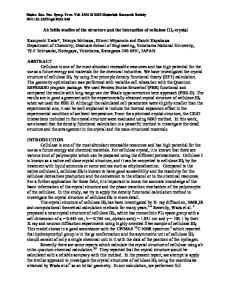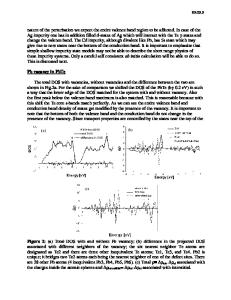Ab initio studies of the crystal structure of cellulose triacetate I
- PDF / 6,417,110 Bytes
- 6 Pages / 612 x 792 pts (letter) Page_size
- 46 Downloads / 362 Views
Ab initio studies of the crystal structure of cellulose triacetate I Takanori Kobayashi, Daichi Hayakawa, Tegshjargal Khishigjargal and Kazuyoshi Ueda Department of Chemistry, Graduate School of Engineering, Yokohama National University, 79-5 Tokiwadai, Hodogaya, Yokohama, Kanagawa 240-8501, JAPAN ABSTRACT We have investigated crystal structure of cellulose triacetate I (CTA I) by using first principal density functional theory (DFT) calculation. The results are in good agreement with the experimentally obtained crystal structure when we used the cutoff energy higher than 70 Ry. However, the cell parameters calculated without dispersion correction are overestimated the results compared to the experimental value. Contrary, with the inclusion of dispersion correction, the cell parameters were calculated slightly smaller than the experimental one. The smaller cell parameter can be considered to be reasonable because the effect of the thermal expansion is not included in the density functional calculation. That is, inclusion of the dispersion term is important in the calculation of this crystal structure of CTA I. INTRODUCTION Cellulose triacetate (CTA) is one of the common cellulose derivatives and has been used as a variety of commercial products such as films and fibers for many years in fiber and textile industries. For CTA, all cellulose hydroxyl groups are replaced by acetyl groups. It is known that CTA has two main types of the crystal structures called CTA I and CTA II which corresponds to cellulose I and II, respectively. According to Sprague et al,1 CTA I can only be obtained by heterogeneous acetylation process of native cellulose I fibers. The crystal structure of CTA I has been investigated by X- ray diffraction, NMR, IR and computational theoretical calculation methods for many years and several unit cell models were proposed.2-4 Although the crystal structure of CTA I has been refined according these models, the exact determination of it is still a matter of controversial. Recently, Sikorski et al. 5 proposed a further refined crystal structure of CTA I with a cell dimension of a = 0.5939 nm, b = 1.1431 nm, c(chain axis) = 1.046 nm and γ = 95.4 by their X-ray diffraction experiments using highly oriented fiber sample of CTA I . This model shows in a good agreement with the observed X-ray diffraction intensities with the crystallographic reliability index of R = 0.224. Besides, CP/MAS 13C NMR spectrum was reported that each ring carbon atom of CTA I only shows a singlet resonance.6 It indicates that the asymmetric unit of CTA I should consist of only a single CTA chemical unit in it. The crystal structure determined by Sikorski et al can well explain the NMR results. Recently there are some reports which calculate the crystal structure of cellulose by using ab initio quantum chemical calculation.7,8 They reported that the crystal structure would be calculated with a reliable accuracy. In the present report, we attempt to apply the similar approach to investigate the crystal structures of CTA I using the co
Data Loading...











